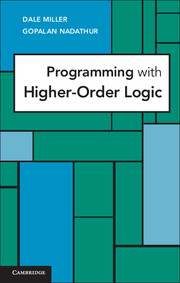Book contents
- Frontmatter
- Contents
- Preface
- Introduction
- 1 First-Order Terms and Representations of Data
- 2 First-Order Horn Clauses
- 3 First-Order Hereditary Harrop Formulas
- 4 Typed λ-Terms and Formulas
- 5 Using Quantification at Higher-Order Types
- 6 Mechanisms for Structuring Large Programs
- 7 Computations over λ-Terms
- 8 Unification of λ-Terms
- 9 Implementing Proof Systems
- 10 Computations over Functional Programs
- 11 Encoding a Process Calculus Language
- Appendix The Teyjus System
- Bibliography
- Index
Introduction
Published online by Cambridge University Press: 05 August 2012
- Frontmatter
- Contents
- Preface
- Introduction
- 1 First-Order Terms and Representations of Data
- 2 First-Order Horn Clauses
- 3 First-Order Hereditary Harrop Formulas
- 4 Typed λ-Terms and Formulas
- 5 Using Quantification at Higher-Order Types
- 6 Mechanisms for Structuring Large Programs
- 7 Computations over λ-Terms
- 8 Unification of λ-Terms
- 9 Implementing Proof Systems
- 10 Computations over Functional Programs
- 11 Encoding a Process Calculus Language
- Appendix The Teyjus System
- Bibliography
- Index
Summary
This book is about the nature and benefits of logic programming in the setting of a higher-order logic. We provide in this Introduction a perspective on the different issues that are relevant to a discussion of these topics. Logic programming is but one way in which logic has been used in recent decades to understand, specify, and effect computations. In Section I.1, we categorize the different approaches that have been employed in connecting logic with computation, and we use this context to explain the particular focus we will adopt. The emphasis in this book will be on interpreting logic programming in an expressive way. A key to doing so is to allow for the use of an enriched set of logical primitives while preserving the essential characteristics of this style of specification and programming. In Section I.2, we discuss a notion of expressivity that supports our later claims that some of the logic programming languages that we present are more expressive than others. The adjective “higher order” has been applied to logic in the past in a few different ways, one of which might even raise concern about our plan to use such a logic to perform computations. In Section I.3, we sort these uses out and make clear the kind of higher-order logic that will interest us in subsequent chapters. Section I.4 explains the style of presentation that we follow in this book: Broadly, our goal is to show how higher-order logic can influence programming without letting the discussion devolve into a formal presentation of logic or a description of a particular programming language. The last two sections discuss the prerequisites expected of the reader and the organization of the book.
- Type
- Chapter
- Information
- Programming with Higher-Order Logic , pp. 1 - 9Publisher: Cambridge University PressPrint publication year: 2012



